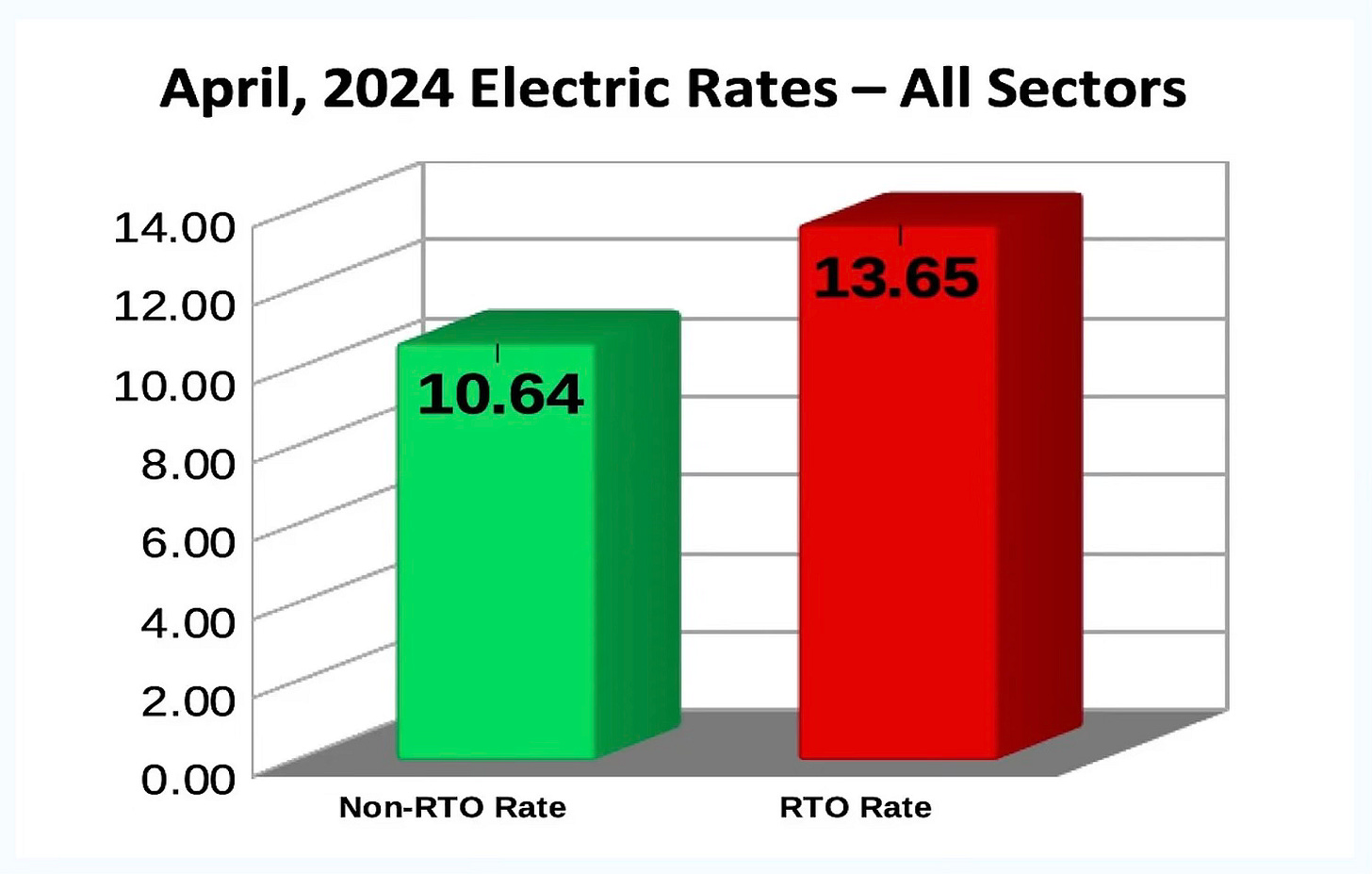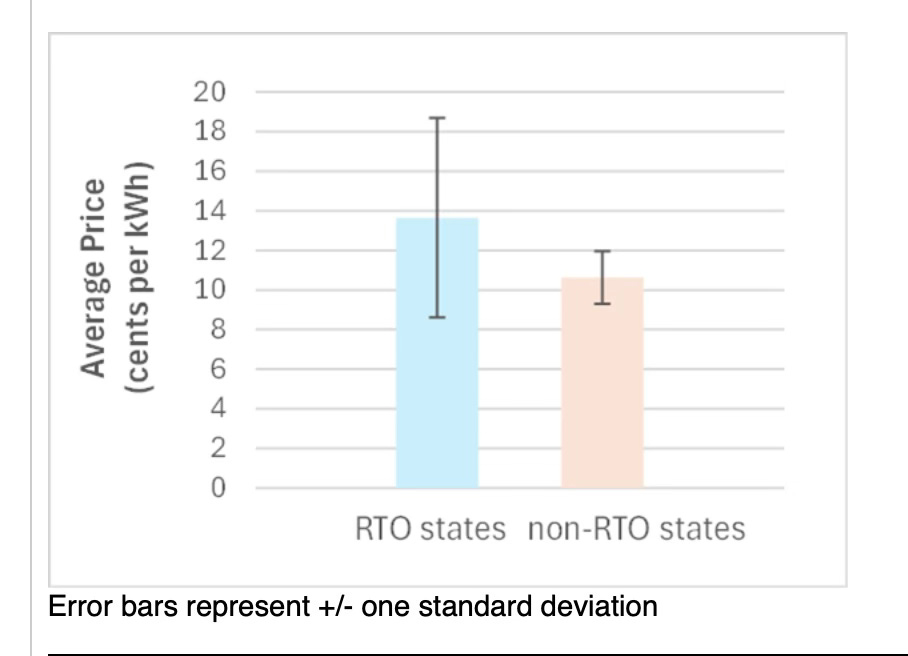What is a real RTO?
Do blue states count?
Debating the RTO
In a recent post at the Energy Security and Freedom Substack, Thomas Shepstone asks a question dear to my heart: Why Are Electric Rates Higher Within Regional Transmission Organizations (RTO) Regions? Dysfunction Maybe?
My book Shorting the Grid is about similar issues. Since Shorting came out in 2020, I was happy to see this update. As a matter of fact, I cross-posted Shepstone’s post at this Substack.
The comments on his post are detailed and informative. Of course, I love reading books, and I even (sort of) enjoy writing them. Still, a book is not a conversation. A Substack post with a comment stream is a conversation!
The blog post itself
Shepstone found the consumer prices for most of the states in the continental United States on the IEA site. He sorted the states into two groups (RTO and not-RTO) and then he made some tables of his results. He concluded that the RTO states have significantly higher consumer prices than the non-RTO states.
The graph at the head of this post is Shepstone’s graph based on his tables. He comments that “Notice that not a single state in the second table (non-RTO states) has a rate above the average for the first (table of RTO states).”
Many people commented on Shepstone’s post. Some wrote in the Comments section of the post, and some commented in a growing email thread addressed to me. Most comments fell into two main groups:
• Do RTO areas have higher consumer prices?
• If RTO areas have higher consumer prices, is it because they are RTOs or is it some other reason?
Higher Consumer Prices
Do RTOs have higher consumer prices? In his chart Shepstone concludes that the average consumer prices are 28% higher in the RTO areas. (Average in this case is the mean.)
Not everyone who read the article agreed. One colleague emailed me to say that this sort of analysis needs some error bars. That colleague took the median (middle value) of each price set, and he also calculated the standard deviation for each price set. His chart appears below. The standard deviation bars overlap, which means there may not be a real difference between the two sets of data. (Due to job constraints, this colleague did not want his name used on this blog post.)
Steve Huntoon, a well-known energy lawyer who frequently writes for RTO Insider, wrote several comments on the Shepstone post. Huntoon suggested that I read a January 2023 blog post by James Bushnell of the Energy Institute of Haas:
(More) Breaking News! California Electricity Prices are Still High!
That 2023 Bushnell post includes two charts: The first graph shows prices of traditional states and “deregulated states.” This graph is an updated version of the graphic used as figure 6 in Shorting. (That graph was by Bushnell and Severin Borenstein, published in 2015.)
The second graph in the recent Bushnell post shows the prices in traditional and “deregulated states,” but with California removed from the averages. The California prices have a separate line, above the other lines on the graph. With California removed, the RTO area prices are a lot closer to the prices of traditional areas.
RTO States: What are they?
Other comments on the Shepstone post have noted similar issues.
Warren Van Wyck’s comment suggests that if you take away the top sixteen Deep Blue states in the charts, the RTO areas have a consumer rate of 9.92 cents per kWh. (The non-RTO areas have an average rate of 10.64 cents per kWh in Shepstone’s calculations.)
Tim Smyth’s comment points out that not all RTOs are alike. Many RTO areas have fully-bundled vertically integrated utilities within them.
My husband George Angwin divided the RTO states into the “Power states” (New England, New York, California) and the “Midwestern” states. (This was part of the email correspondence, not in the Comments section.)
George wrote:
“1. Note that the Midwest RTO states and the non-RTO states have indistinguishable means, while the 95% interval of the Power RTO states barely overlaps that of the other groups.
“2. I conclude that the original question is wrong: the RTO states do not form a coherent population, so comparing them to the non-RTO states will not be very illuminating.”
RTO areas have higher consumer prices
Let’s answer the first question first. Do RTO areas have higher prices for electricity?
Yes. RTO states do have higher consumer prices for electricity. We can avoid this fact by saying that we shouldn’t count California, or we shouldn’t count Deep Blue states or whatever. However, if we look at the data in the most simple way:
this state IS in an RTO,
that state IS NOT in an RTO,
when we take the averages, the RTO states have higher consumer prices
Can someone please ask why RTOs have higher consumer prices?
I wish someone would ask why the RTO areas are more expensive!
Of course, I asked in Shorting, and my theory was that RTO governance tends to higher prices. Perhaps this is only because RTOs tend to encourage redundant overbuilding of renewables-plus-backup. On the other hand, what about the Midwestern bundled utilities, or the effects of being a “power state” or a Deep Blue state?
I will end by paraphrasing one of my comments on the Shepstone post:
Why aren't there lots of studies, maybe one or two every year or so, comparing the consumer costs in RTO and vertically integrated areas? The studies could compare taxes, social programs, percentage renewables, cost of imports, all sorts of things.
I think that these studies (which pretty much don't exist) would answer a question that a lot of people don't want answered. I am pretty sure that such studies would show RTOs as more expensive. I don’t think there are going to be lots of new studies in this area.
Ask me no questions
My mother used to say, “Ask me no questions and I will tell you no lies.” She said this when I asked a question that she felt was none of my business.
Is someone saying the same thing about the costs of RTOs?




It’s really silly to look at power costs without talking about underlying fuel costs. Why are New England power prices so expensive? Because the region refuses to build natural gas infrastructure.
I don't have an opinion on this specifically, nor the detailed experience to comment (I am not American). I will say that I have wondered about deregulation generally. Ontario, where I live, has a kind of blended model, Alberta is pretty much a deregulated model, and many provinces retain the provincial utility, vertically integrated, Crown Corporation model. Power rates vary widely in Canada by province, but this has more to do with local resource types than the bower business model. IN the 1980s and 1990s it was a fad to dereg and have more 'competitive markets' in power to supposedly reduce costs, but personally for such complex systems that are often natural monopolies, I was never convinced.